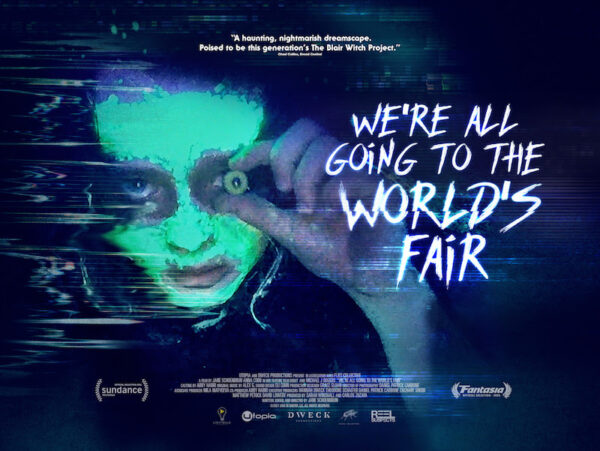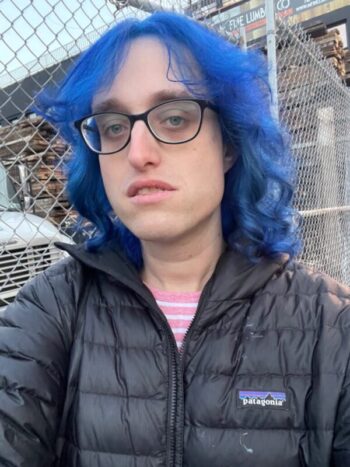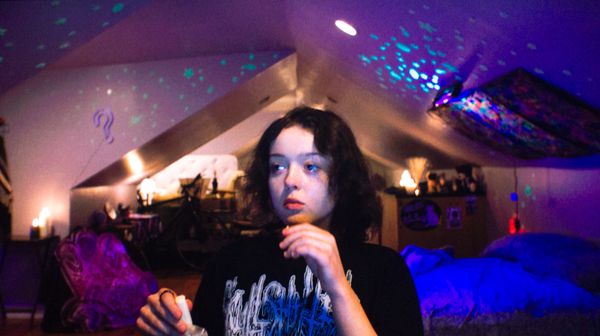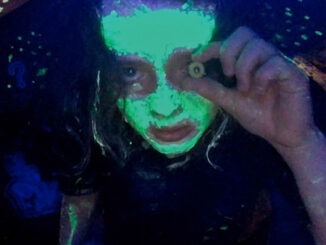
Alone in her attic bedroom, teenage outcast Casey becomes immersed in an online role-playing horror game, wherein she begins to document the changes that may or may not be happening to her. It’s a premise that may sound familiar – particularly to people who grew up in the era of CreepyPasta or Slenderman – but you haven’t seen it like this. We’re All Going To The World’s Fair was among my favourite movies last year after watching it at GrimmFest. It even made my top 15. As such, it was my absolute pleasure to speak with writer/director Jane Schoenbrun. Here we discuss the artistic process, art meets commerce, the good and bad of the Internet, capturing a transgender experience in genre cinema and Hollywood “wokeness”. Please note that the interview has been slightly edited for clarity – both in how questions were asked and answered. For the full version, look out for our latest podcast. Also, there are no spoilers: it’s best to go in blind, so we do not reveal anything that isn’t implied in the premise above.
This is a film that’s meant to resemble something that we’d see on a laptop, so how has it been watching that on a big screen?
You know, it was important to me that the movie work in a theatre. The film, I think, is strange in terms of the genre elements in that I don’t know that I would call it a horror film. It’s certainly a film about people who love horror, and it certainly plays with tones and aesthetics and genre motifs that nod to horror – or unpleasant things at the very least. But it’s as much, to me, an art film and is very much inspired by a lot of slow cinema – contemporary Asian cinema filmmakers like Tsai Ming-Liang and Kiarostami, the Iranian filmmaker. I wanted to make a film that felt dreamlike and trancelike, and I think that’s represented in the found footage moments of the film. They are all about duration, they’re all about lulling you into certain States. But the more Cinematic moments in the film are similarly all about sound and image and movement. For some moments in the film, we’re just watching the character walk through the snow at night with a lantern for two or three minutes. And I think I know enough about how I watch movies to know that’s something it’s a lot easier to be transported by in a movie theatre – it’s a lot easier to give yourself to the dreamlike experience of cinema when it’s dark and there’s a giant screen in front of you it’s surrounding you. And that’s, not to say that I don’t also love the experience of people watching it on a laptop. But it was a movie made for the cinema, and the idea that people get to watch it in that space now after such a long pandemic is really lovely.
In a recent interview, you said when people make films they’re not doing it because they have answers, but because they have questions. So what sort of questions were you asking yourself with We’re All Going To The World’s Fair?
It’s a great question. If my film is successful, I really believe that you leave it maybe a little frustrated because there’s more work to be done – just as there was more work to be done when I was sitting down to make the film. It’s an investigation of many things, but it’s not an investigation that leads to firm answers – nor should it be. I think it’s trying to express and find language for feelings and ideas and realities or perceived realities of my experience in the world – and the experience of people like me, perhaps, in the world. But it’s not trying to be prescriptive and give you a lecture on that – it’s supposed to be the beginning of a conversation that you can continue for yourself in your own brain or with friends or on the Internet or wherever. You know, for me, it’s a film very much about a word. And when I started working on the movie, I didn’t know this word yet, and that word is dysphoria. It’s a film about growing up on the Internet as a teenager and feeling unreal. Feeling a sense of frustration and a sense of your life not being your own. A sense of unreality that you can’t quite grasp. And so, you go looking for it in spaces that are decontextualised from both your body and from the world. And it’s about the relationship between truth and fiction, which is obviously something that both on the Internet and in real life is complicated. We use fiction to explore ourselves and explore darker impulses that we might have, in a safe space. Or a safer space. And it’s about the ways we relate to one another in our changing world and how our world is changing. I think perhaps above all the other ways is through this strange glowing box that we spend so much of our time engaged with.
There’s something tragic in how the audience will make suppositions of the relationship between the two characters that go way beyond Casey’s understanding of the situation. When it came to casting her, how did you go about auditioning the role? Did you and Cobb build the character together?
When I write a character, I try to write them about 70% fully realised on the page because I think I’m hyper-aware that my ideal creative process is one of collaboration. It’s one of not trying to fit reality into the box that you’re trying to fit into it into. But to collaborate with reality and in this case, specifically with an incredibly talented individual performer. That was something that was very much invited in. When we saw Anna’s tape, and got to know Anna, it immediately became clear that she was an extremely special person. And even though she was incredibly different from Casey, she had this charisma and personality and deep, complicated depth. That made it so clear that this was somebody you could dig – to find the depths of this character, who is also very complex. She’s also an enormously talented performer with an incredible gift and an incredibly disciplined work ethic. There was a months-long process of preparing for the shoot so that she could feel comfortable disappearing into the role in the way you see in the film. So much of it was about finding a common language between the two of us and merging my idea of who this character was with who she was and what she was interested in exploring as an artist and performer.
Apologies if my cat starts meowing – I thought I closed the door.
That’s fine – I appreciate the company.
It’s a very fearless performance: I’m thinking of the bit where we got her dancing for an uncomfortably long time. She’s the kind of character you want to give a hug, but at the same time, she wasn’t necessarily playing it for pity. She’s just Casey doing her thing.
I liked the idea, and I think it’s a core idea to the Internet: you’re maybe not sure what to feel at any given moment. When you’re watching this character who is very much performing for the majority of the film – she’s very much aware of the camera’s presence – if not our camera’s presence, a camera’s presence. This character is trying to express something about herself. There’s a reason that camera is on, and she’s recording herself – she wants us to see something. So, in that way, it’s a very ambiguous and ambivalent film. My favourite moments, of which that dance scene is one of them, are the moments when you’re not sure whether you should be terrified, sad or laughing. I love any moment in cinema that can confuse your brain and heart: almost collapsing a binary of this is sad, this is happy, this is scary, or this is romantic. And I think Casey is chasing that as well.

With the mystery element you talked about, were there a lot of aspects of the story that you had figured out but chose not to include by design? Or even to yourself, did things like the challenge’s origins remain unknowable?
I did literally write a 10-page fake Wikipedia page overview of the history of the World’s Fair challenge. There’s a David Lynch quote I really like that says the mystery should feel like the answer ‘is waiting for you somewhere in the next room over’. And I love that because it feels true to life, and it feels true to falling into communities and strange places on the Internet. When you first land there, you can tell that there’s a logic, but that logic is perhaps oblique and overly complicated. And so, the mythology of the film, and this CreepyPasta all of these people are participating in, and have been for years, like the saturation and an inherent schizophrenia of all of these voices on the Internet collaboratively creating a narrative has to feel like that. We have to feel a little bit lost, so this was intentional. But beyond that, beyond the mythology and the origins of the game, the margins needed to be precise. And for very motivated and specific reasons, I wanted to make a film that felt truthful to the experience of using the Internet and truthful to the experience of relationships on the Internet. And a lot of context gets lost in that space – it can be hard to know who is telling the truth and who is fucking with you. It can be hard to know who is going to be there tomorrow – it’s a space that invites a lot of ambivalence and ambiguity, and I wanted to make a film that was truthful to that rather than trying to water that down to a Cinematic narrative language.
And when you’re dealing with something as subject to change as the Internet was there a lot of watching other people vlog so it came across as authentic? I’m thinking of that meme “hello fellow kids”.
Yeah, the first thing is I felt strongly that I didn’t want to situate the movie in a specific time period, as the movie is so dreamlike and impressionistic. One of my early rules for myself, is that this wasn’t supposed to be a “realistic” portrayal of the Internet. This was supposed to be a portrayal of my gaze on the Internet, and as such it’s as much a gaze on the Internet of my youth – the grainy 56 K dial up version of the Internet pre-YouTube that I grew up with. As well as also speaking about the heyday of early YouTube, when CreepyPasta was at its height. As much as it’s about this sort of cluster Fuck of social media algorithm logic, we’re all unpacking as a world on the Internet in 2022. But I also really wanted to make a movie that felt like it was not speaking down to the Internet. When you watch a lot of films about the Internet, they’re not necessarily made by people who grew up on the Internet or needed the Internet and desired to be on the Internet – and I am very much a person who spent a good deal of their emotional energy in these sorts of spaces. And so, it felt so important to me that the film not be pastiche or parody or look down on these communities. One very tangible way that I addressed that was working with a lot of the actual people involved in the CreepyPasta movement whenever possible. We were working with real people in a very collaborative way – there are entire scenes in the film shot by essentially Youtubers who are making the kinds of content that the film is speaking about. For me, the nightmare scenario was that the film felt like one of those Hollywood movies where they’re shooting on a fancy camera and pretending it’s a selfie. And it’s some Hollywood actor doing their impression of another Hollywood actor’s impression of YouTube. If this film is going to work it has to feel like a transmission from the genuine Internet.
Speaking of collaboration, I saw that you’ve done a lot of collaborative work in the past, including a really cool sounding project where filmmakers interpreted each other’s dreams. How’s it been finding your own voice after working with so many people?
Sort of a non-traditional path, but one thing I think set me up to think deeply about my own voice as an artist, was insecurity – and insecurity that was accentuated by the fact that I hadn’t come out to myself yet, as trans. And that so much of my identity was something that I was pushing down, and that I wasn’t ready to speak about as myself as an artist. The process of coming out to myself and figuring out my voice and identity as an artist was very much tied up in figuring out what my first feature as a director should be. But the work I was doing before then was perhaps less traditional – I didn’t make a lot of like narrative shorts in the same world with crews building up to making my first feature. But I did do a tonne of work immersing myself in DIY, alternative micro-budget film scenes in New York and across America regionally. I worked at various film organisations in my 20s, meeting young filmmakers who were all in their own way kind of confronting this big problem that we have in America: the tension between being an artist who wants to make personal work and being somebody who has to make that work within a commercial system that’s looking primarily at a bottom line of profit. In our late-capitalist current day, that’s quite a tension. I found a lot of filmmakers, collaborators and artists who I was just a huge fan of, who I learned from and who I watched go through this process of making early work and growing as an artist. And I think both finding my voice through the work that I was drawn towards, and also finding a real understanding of the realities of trying to make art in a commercial landscape, this was an invaluable decade of apprenticeship before I was ready emotionally to commit and to make my own work.
With recent mainstream horror we’ve seen more of a conscious attempt to do films that address social issues and celebrate aspects of outsiderdom – something that’s been going on with the independent circuit for decades. But, from a mainstream perspective, are we still a long time away from seeing a horror that deals with trans issues?
No, I assume that Hollywood is trying to commodify transness, just like Hollywood is trying to commodify everything. I suspect that if you did see a big-budget mainstream Hollywood horror film, or I guess as the term is now “social thriller”, in the vein of Get Out, it would be like dysphoria as the metaphor is like a ghost or a monster tracking people who have to defeat it. I’m pretty bored by this. I love Get Out, but I’m pretty bored by contemporary commercial horror. Because yes, it’s about letting new voices speak. But it’s about letting them speak in a very rigid and conservative form – still adapting to what I think was a language of narrative cinema. That was created by the people in charge of a power structure – in charge of a white supremacist, capitalist, male-driven power structure. It seems to me that the question of how you can authentically express a trans experience through the language of cinema inherently has to involve expanding cinematic language. Or at the very least, rewriting and evolving genre conventions. And as much as I’m happy to see minorities, especially queer and trans filmmakers, getting fledgeling attention from people with the resources and money to let those voices reach out into the world, I’m hesitant to get too optimistic about it. Because I think those voices get watered down by a power structure that’s not sharing the goal of speaking authentically and envisioning new worlds and new experiences through the language of cinema.

I agree, and the authentic voice is what I should have specified. I’m thinking about when people talk about the BBC, or Disney or Netflix, if they’re woke. If they are, they’re pretty bad at it. Disney has yet to have an LGBT protagonist and chose to make a film where genocide was happening. At the same time, in the “culture wars” there’s such a push back against diversity and inclusion – “it’s an agenda” becomes the follow-up.
It feels like you get too deep into this conversation, and suddenly, you’re speaking a language that’s so foreign to how I perceive and understand my place in the world. Whether someone or some giant capitalist business entity is woke or not woke is this binary question that has nothing to do with my lived experience in the world. My lived experience in the world is I’m looking around and seeing a power structure and a society and a culture that feels like it’s breeding inequality and injustice. And spaces where people who want to express themselves with autonomy and freedom are being hunted down and made to fear for themselves and mask themselves from the world. I’m an artist: I want to explore these things in work, in really complex, personal ways. I don’t want to give people answers about things – I want to start conversations that feel emotionally truthful to me, and you hope that you’re doing some form of care-work by doing that. You’re helping articulate experiences that have been previously unarticulated. I just feel so alienated by any kind of conversation about “wokeness” or “PC culture”. It feels like bad actors invented these words to keep us in boxes and keep us from expanding our understanding. And expanding our ability to live in a world that feels exciting.
I understand you were also using the film to explore your own gender identity. Could you expand on this process of understanding yourself through what you create? Obviously, the art you make will always be a projection of yourself. But at the same time, how do you learn from the things you’re putting out there?
Yeah, that’s a great question. I think it all starts from creative practice. It starts from developing an ideally daily practice as an artist, through which you are translating the things you’re trying to explore into art. Into something that is speaking through whatever medium you’re trying to speak through in a way that will resonate. In the way that you’re hoping that it resonates. And that’s a tough thing to do. I think it starts with this flicker of a flame; it begins with really going deep inside yourself and asking yourself what is my most visceral obsession, or the most authentic way of articulating the thing that feels like I need to articulate. This is a very academic or vague answer because I’m talking about things that I think language doesn’t necessarily exist to explain. But I think it starts from this place of finding your voice – finding a way to project your perception, the inside of your brain, out of your brain so that other people can understand it and hopefully find comfort or see themselves within it. And you have to start small. I think you have to chase trying to make visible something that feels invisible. To take something out of your brain and onto a screen in small, small ways. Once you learn to do that and find that first sort of flicker, you can grow the flame, and you could grow the language. You could start speaking on bigger canvases – and you can start to understand this infinitely deep process of trying to articulate the infinite complexities of the human experience in this medium of light, sound, and time. You can start to understand how that can evolve and grow as you evolve and grow your practice – and that’s always going to be deeply personal. And deeply personal in different ways. Like I’m now two years into my physical transition, and when I was doing this process on World’s Fair, I hadn’t even realised I was trans yet. So, I’m such a different person and my language is evolving, as my life evolves. My interests are maybe still the same – I’m still staring at the same flame. But it’s from a different perspective, or it’s glowing in a different way now.
Finally, you mentioned bigger canvases. Have you got a particular piece of work in the pipeline?
We’re five weeks out from prep on my new film, which is so exciting. It’s a much bigger film called I Saw The TV Glow
That’s a beautiful title again.
I’m doing it with A24, and it’s being produced by Emma Stone and Dave McCary’s Fruit Tree Productions. It’s about these kids who are obsessed with a scary TV show, and then they grow up and that scary TV show continues to have strange impacts on their lives. And yeah, we’ll shoot it this summer. It’s almost like working in a completely different medium. It’s so cool to get to have the resources to make monsters and to do some crane shots and explore, like I said, the same flame. But in a much, much-expanded canvas.
Brilliant. Thank you very much for joining us.
Thank you, David.
We’re All Going To The World’s Fair arrives in UK cinemas from April 29, Digital Download May 9 and Blu-ray 23rd May. Book your tickets and pre-order your copy here: https://linktr.ee/worldsfair




This was an incredible interview, so insightful